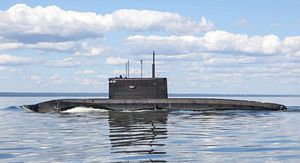The Russian Pacific Fleet will induct into service its first improved Project 636.3 Kilo-class (aka Vashavyanka-class) diesel-electric attack submarine (SSK) on November 25, the Russian Ministry of Defense (MoD) announced in a statement today.
“A ceremony will take place at the Admiralty Shipyard in St. Petersburg on November 25 to accept the first Project 636.3 diesel-electric submarine Petropavlovsk-Kamchatsky for service in the Pacific Fleet,” the statement reads. “The St. Andrew’s [Russian naval] flag will be raised on the submarine.”
The Petropavlovsk-Kamchatsky, laid down in July 2017 along with the Project 636.3 SSK Volkhov, successfully completed the final round of sea and user trials in the Baltic Sea earlier this year. It is unclear when the SSK will become fully operational with the Pacific Fleet.
Two additional SSKs of the class were laid down at the beginning of November. The St. Petersburg-based Admiralty shipyard is expected to deliver a total of six new improved Project 636.3 SSKs to the Russian Navy’s Pacific Fleet by the end of 2025. The Volkhov is slated to join the fleet in late 2020 or 2021. As I wrote previously:
Between August 2010 and November 2016, Admiralty shipyard built six improved Project 636.3 SSKs for the Russian Navy’s Black Sea Fleet. Five of the subs were deployed to the eastern Mediterranean, with at least two reportedly attacking land targets inside Syria with M-54 Kalibr (NATO designation: SS-N-27A “Sizzler”) cruise missiles in 2015 and 2017.
The improved Project 636.3 Kilo-class SSKs (nicknamed “Black Holes” by the U.S. Navy) has primarily been designed for anti-submarine and anti-surface ship warfare. The SSKs are known for their quietness and feature some of Russia’s most advanced submarine technology, as I explained elsewhere:
The Project 636.3 Kilo-class is an improved variant of the original Project 877 Kilo-class design. The updated version is slightly longer in length — the sub’s submerged displacement is around 4,000 tons — and features improved engines, an improved combat system, as well as new noise reduction technology.
Notably, the SSK class, however, is not fitted with an air-independent propulsion (AIP) system. A first Russian-made AIP will not be ready for testing until 2021 or 2022, according to the Rubin Design Bureau.
The submarine has a crew of 52 and can conduct underwater patrols for up to 45 days. The sub can dive to a maximum depth of about 300 meters and has an operational range of up to 12,000 kilometers.
The SSK is armed with both torpedoes and cruise missiles, the latter of which are launched from one of six 533 millimeter torpedo tubes.

































